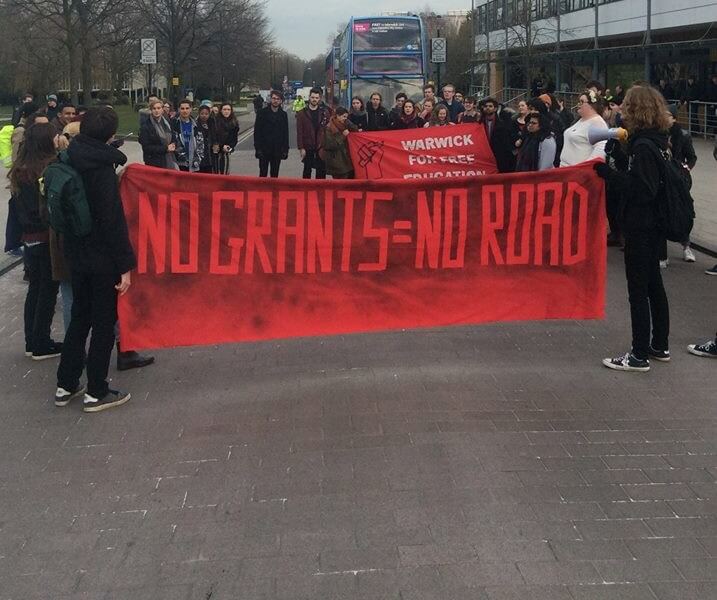Performance is the most potent form of protest
Ahead of Protest and Performance Week at Warwick, The Boar takes a look at some of the most influential artistic protests in the last few decades as well as protests closer to home.
On Friday 26 February, Warwick For Free Education (WFFE) took over University Road in an attempt to protest against governmental decisions to scrap maintenance grants for students. This had a fairly mixed reception: some came out in full support of WFFE’s actions, while others (notably Warwick student George Lawlor) were not so impressed. Lawlor argues that ‘all they’re really concerned with is their own egos and feeding them with vapid, self-congratulatory activism’, and it got me thinking – how much of their protest was actually about being angry at the system, and how much was about putting on a performance, a show of some kind?
This kind of performance brings attention to the issues at hand – no one is questioning that these need to be urgently addressed. But for how long can students continue to disrupt other students and university employees when they’re not the ones who’ve done anything wrong, and crucially, they have limited power to actually stop perceived injustices? And with such theatricality involved in the protest, is it having enough of an impact in the real world?
Students discovered that the university was holding records on students’ political views and making biased decisions on this basis.
Student ensemble FellSwoopTheatre, part of Warwick’s IATL, is taking a different approach. Performer Siobhán Lynn talked to The Boar about FellSwoop’s upcoming reprisal of their devised show ‘To Know How You Stand’ for P&P Week. The show looks back over the history of protest at Warwick: from the pepper-spraying of protesters in Senate House in 2014 right back to the occupation of the registry in the 1970s, when students discovered that the university was holding records on students’ political views and making biased decisions on this basis, ‘To Know How You Stand’ utilises aspects of physical theatre to explore the university as a protest space.
Of course, we must look outside the Warwick bubble to get the bigger picture. In focusing on students, FellSwoop is looking at one aspect of a much wider social question, a question which is brought to the fore in the National Theatre’s revival of Sarah Kane’s contentious play, Cleansed, which has recently sparked controversy. The play is perhaps a more obvious backlash against a cruel, uncaring social system than other protest works might appear to be, but the reason behind the outcry is the level of obscenity – many argue that it’s some kind of sadistic endurance test, to see how much blood, gore, sexual abuse and torture the audience can handle before they finally crack. At this point we must ask: where can the line of artistry be drawn? When does the violence become gratuitous – or are we just too uncomfortable to deal with the real issues?
Talking of real issues, protest has been extended from the world of theatre to the general political sphere. Take last weekend’s CND rally in London against the renewal of Trident – yet another protest that Labour leader Jeremy Corbyn has attended since becoming head of the party. Corbyn has interestingly been praised by some for his refreshing approach to politics, removing theatricality from his daily ‘performances’ in contrast to the peacocking superficiality of some of his Conservative counterparts. David Cameron’s various football faux pas in the past, if we’re just considering one trivial example, reveal him to be constantly putting on a performance of some kind in order to garner more support, whereas Corbyn’s example shows that protest doesn’t have to be theatrical to be effective. I, for one, admire his more down-to-earth responses in all the childish bluster of Westminster tradition.
Satire works as part of a movement to educate those misguided souls who actually believe that Trump could have anything but a negative effect on US politics.
But even we can be marginally more grateful for our smooth-talking, over-privileged cabinet members when we look across the pond at Republican nominee Donald Trump (who is in his own way a kind of performance artist) and the wealth of comedic protest art that he has inspired. American artists including Saint Hoax, Sarah Levy and Hanksy have used everything from Photoshop to street art to protest against Trump’s controversial views. So much effort has gone into the anti-Trump campaign – yet people still don’t seem to fully grasp how dangerous he is as a symbol of power, and he continues to have mass appeal across America. So what effect does this kind of protest art have? Satirising a man who is ultimately one of the most laughable figures currently active in global politics is part of a movement to educate those misguided souls who actually believe that Trump could have anything but a negative effect on US politics, to try and make them see that he is a joke, and a deceptively threatening one at that. It is this artistic education that is the most potent form of protest.

Comments (1)
Arrange your BC planhing team and be sure that the cdew coinsults and communicates with all
employees and workers.